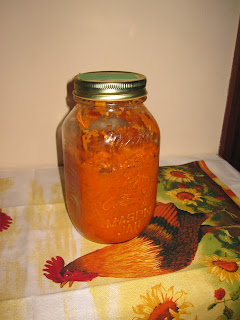 |
| Fulvic Minerals and additives--ginger, beet, lemon balm, tea. |
The
Fulvic Ionic Minerals I use daily combine fulvic acid, humic acid, electrolytes, essential amino acids and minerals to provide a bio-available source of these incredible, health-giving nutrients. After dissolving only a few drops of the liquid in clean water (I use rain water as our tap water contains chlorine), I provide my body with an amazing start to each day. By balancing and energizing the cells, the body becomes better able to absorb and utilize nutrients. Even better, this morning drink stimulates the immune system. The Fulvic Ionic Minerals we use, from
Optimally Organic, are sourced from humate deposits in the southern United States, derived naturally, and packaged in amber-colored glass bottles.
Of late, I have taken to doing more with the Fulvic Ionic Minerals than simply adding them to water. By adding them to water with a tea bag or fresh herbs, the nutrients and flavor of the tea or herbs become rapidly dispersed through the water. Indeed, I am entertained by watching just how fast some of these processes happen. Yesterday I experimented with green tea, ginger and beet root on video, and some lemon balm leaves and red bell pepper juice (after turning off the camera). Unfortunately, the video is not uploading to this Blogger post correctly, and all I have to share, then, are these still photos.
 |
| Left to right: Fulvic Minerals, green tea, ginger juice, beet chunks. |
The green tea performed as expected. Normally, a tea ball added to cold water will produce little if any tea infusion; however, with the Fulvic Ionic Minerals added, in practically no time a dark, smoky haze emanated from the ball. After a bit of dunking, we had a glass of tea so green as to be practically black. The flavor was quite rich.
The ginger root was fairly fresh and produced juice readily when squeezed in the garlic press. Although the color in the mineralized water was unremarkable, the flavor was amazing. With a bit of carbonation, this would make an excellent home gingerale. (Adding a bit of agave nectar might help for those with a sweet tooth.)

The beet root was not as fresh and did not produce juice when squeezed. I shall have to try this again when we have fresh beets available.
The lemon balm took a little time to blend. Although I bruised the fresh leaves between my fingertips before adding the herb sprigs to the water, I did not observe a rapid reaction after adding the minerals. Some minutes later, though, the liquid appeared darker and the flavor was incredibly lemony.
Lastly, the red bell pepper--which was fresh from the garden--- readily emitted several drops of juice from a small slice. With the added minerals, the resulting "tea" had a pleasing flavor. Not that I have drunk bell pepper tea before, but the sweetness of the fresh pepper was readily available to the palate.
Try your own combinations at home and be sure to share your experiences in the comments section. Thanks for reading!





















